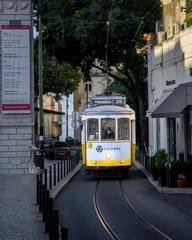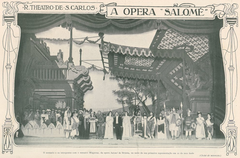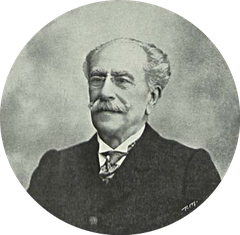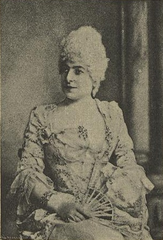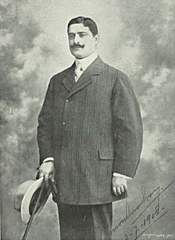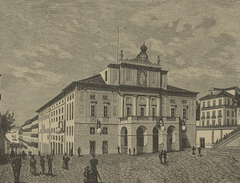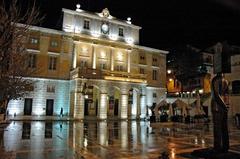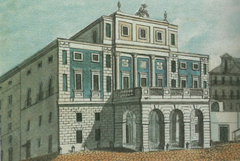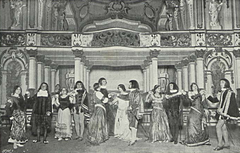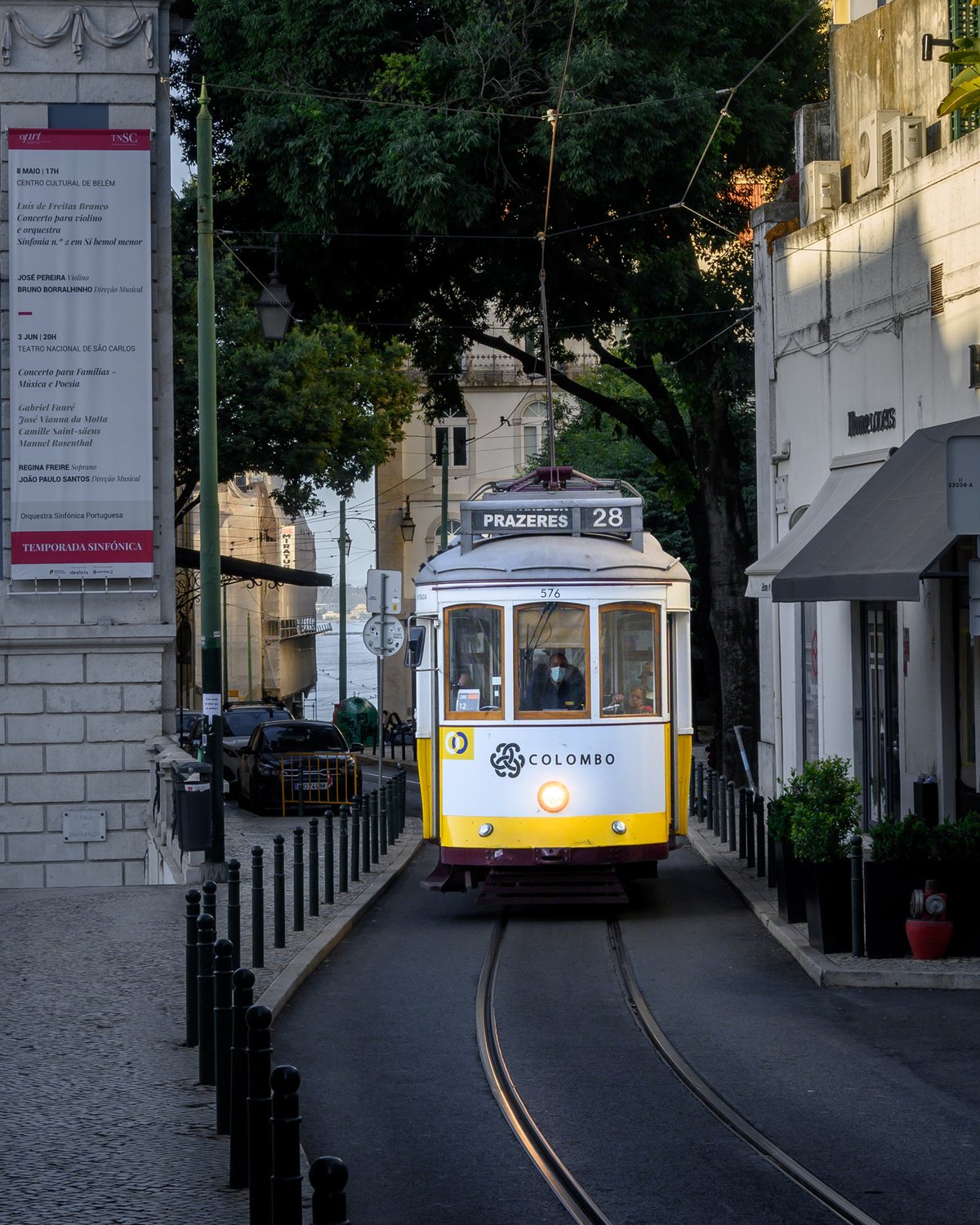
Teatro Nacional de São Carlos: Visiting Hours, Tickets, and Complete Visitor Guide to Lisbon’s Historic Opera House
Date: 14/06/2025
Introduction
Located in Lisbon’s historic Chiado district, the Teatro Nacional de São Carlos is a beacon of Portugal’s rich artistic heritage and a must-visit destination for lovers of opera, architecture, and cultural history. Since its inauguration in 1793, this neoclassical masterpiece has captivated audiences with world-class performances, exquisite interiors, and a vibrant community spirit. This comprehensive guide details everything you need to know about visiting the Teatro Nacional de São Carlos, including its history, architectural highlights, visiting hours, ticketing information, accessibility, and tips for making the most of your visit to one of Lisbon’s premier historical sites.
Table of Contents
- Theatre Overview and Cultural Significance
- Historical Background
- Architectural Highlights
- Cultural Programming and Impact
- Visitor Information: Hours, Tickets, and Tours
- Accessibility and Inclusivity
- Nearby Attractions in Chiado
- Frequently Asked Questions (FAQs)
- Conclusion and Call to Action
- References
Theatre Overview and Cultural Significance
Teatro Nacional de São Carlos stands as Portugal’s only purpose-built opera house, serving as the country’s epicenter for opera, symphonic music, and ballet. Commissioned by Queen Maria I after the 1755 earthquake destroyed the Ópera do Tejo, the theatre’s creation was a statement of cultural resilience and ambition. Its enduring legacy is marked by its role in introducing generations of Portuguese audiences to the world of opera and its commitment to artistic excellence through accessible programming and community festivals such as the Festival ao Largo (Lisbon Tourism; Lisboavibes).
Historical Background
Origins and Early Years
The theatre was inaugurated on June 30, 1793, filling a four-decade void in Lisbon’s cultural scene left by the 1755 earthquake. Designed by architect José da Costa e Silva, who drew inspiration from Italian opera houses like Milan’s La Scala, São Carlos quickly became a symbol of Portugal’s Enlightenment ideals and royal patronage (Portugal.com).
Evolution and Restoration
The 19th and 20th centuries saw São Carlos adapt to changing artistic trends, hosting premieres, embracing the Romantic movement, and withstanding fires and financial hardship. Key renovations—such as the addition of the Duques de Bragança annex in 1888 and the Serpa Pinto annex in 1933—expanded the theatre’s capabilities while preserving its historical character. Major restoration projects have ensured its continued operation and national monument status (Portugal Visitor).
Architectural Highlights
Neoclassical Façade
The theatre’s exterior is a model of neoclassical balance, with pale stonework, six Ionic columns, and a triangular pediment marking its entrance on Rua Serpa Pinto. The restrained elegance of the façade contrasts with the ornate, late Baroque opulence that awaits inside (trienaldelisboa.com).
Lavish Interiors
Inside, the horseshoe-shaped auditorium features gilded stucco, plush red velvet, and elaborate rococo decorations. Ceiling paintings by Manuel da Costa and Cirilo Wolkmar Machado, along with the Salão Nobre’s mirrors and chandeliers, evoke the grandeur of 18th-century European opera houses (saocarlos.pt). The auditorium’s elliptical design ensures excellent acoustics for up to 725 guests.
Artistic and Decorative Features
Decoration by Giovanni Appianni, gold leaf accents, and period furnishings enhance the theatre’s atmosphere. Recent renovations funded by Portugal’s Recovery and Resilience Plan (PRR) have modernized technical infrastructure and improved accessibility while preserving historical features (saocarlos.pt).
Cultural Programming and Impact
Teatro Nacional de São Carlos is home to the Orquestra Sinfónica Portuguesa and the São Carlos Choir, offering a diverse program of classical and contemporary opera, ballet, and symphonic concerts. The annual Festival ao Largo opens the theatre to the public with free outdoor performances, and educational workshops, guided tours, and community initiatives deepen its local and national impact (Lisboavibes; Visit Lisboa).
Visitor Information: Hours, Tickets, and Tours
Visiting Hours
- Box Office: Monday to Saturday, 13:00–19:00; extended hours on performance days.
- Guided Tours: Usually available on weekdays by advance booking. Tour schedules may vary; always check the official website for current times.
Tickets
- Buying Tickets: Online via BOL – Bilheteira Online, at the box office, or through authorized agents (e.g., Teatro Camões, El Corte Inglés, Fnac, Worten).
- Prices: Range from €10–€80 depending on seat and production. Guided tour tickets are approximately €10; discounts for students, seniors, and groups are available (TNSC Bilheteira).
- Payment: Cash, Multibanco, Visa (except American Express), and cheques for large amounts.
Performance Schedule
The theatre’s season runs from autumn to late spring, with select summer events. Check the official calendar or Operabase for the latest listings. Notable upcoming events in June–July 2025 include Bernstein’s “Wonderful Town” and major choral concerts.
Guided Tours
Guided tours provide exclusive backstage access, historical context, and a close look at architectural highlights. Tours last about 60 minutes and can be reserved online.
Visitor Guidelines
- Age: Suitable for ages 6+, children under 3 are not admitted.
- Dress Code: Smart casual; formal attire is common for premieres.
- Photography: Allowed in public areas during tours; not allowed during performances.
- Mobile Devices: Must be off during performances.
Accessibility and Inclusivity
The theatre is fully accessible, offering wheelchair entrances, elevators, and designated seating. Staff are trained to assist guests with special needs. Special ticket discounts, open-air events, and community programs enhance inclusivity (trienaldelisboa.com). Some performances offer English subtitles; check program details for availability.
Nearby Attractions in Chiado
Combine your theatre visit with other Chiado highlights:
- Café A Brasileira: Historic literary café
- Museu Nacional de Arte Contemporânea
- Rua Garrett: Shopping and bookstores
- Convento do Carmo: Gothic ruins
- Santa Justa Lift and Praça do Comércio: Iconic city landmarks
The area is pedestrian-friendly and accessible via metro (Baixa-Chiado), tram, and bus (Portugal Visitor).
Frequently Asked Questions (FAQs)
Q: What are the Teatro Nacional de São Carlos visiting hours?
A: Box office open Monday to Saturday, 13:00–19:00. Tours and performance times vary; check the official website for updates.
Q: How can I buy tickets?
A: Purchase tickets online, at the box office, or through authorized outlets like Fnac and El Corte Inglés.
Q: Is the theatre accessible for visitors with reduced mobility?
A: Yes, with accessible entrances, elevators, and seating. Contact the box office for assistance.
Q: Are guided tours available?
A: Yes, generally on weekdays by advance booking. Tours cover the auditorium, Salão Nobre, and backstage areas.
Q: Are there discounts on tickets?
A: Yes, for students, seniors, and cultural professionals at box offices with valid ID.
Q: What attractions are nearby?
A: Chiado’s cafes, museums, shops, and historic sites like the Convento do Carmo and Praça do Comércio.
Conclusion and Call to Action
Teatro Nacional de São Carlos is more than an architectural marvel—it is the living heart of Lisbon’s operatic and symphonic tradition. Its blend of neoclassical elegance and Baroque luxury, combined with dynamic cultural programming and a welcoming atmosphere, promises visitors a truly enriching experience. Whether attending a dazzling performance, joining a behind-the-scenes tour, or exploring the vibrant Chiado district, the theatre is an essential stop on any cultural itinerary in Lisbon.
Plan your visit today:
- Check the official website for up-to-date schedules, ticketing, and tour information.
- Book tickets in advance, especially for popular performances.
- Download the Audiala app for curated guides, event alerts, and exclusive offers.
- Follow Teatro Nacional de São Carlos and Audiala on social media for news and insider tips.
References
- Lisbon Tourism – São Carlos National Theater
- Lisboavibes – Theatres in Lisbon
- Teatro Nacional de São Carlos – Official Website
- Operabase – São Carlos Performances
- Portugal.com – São Carlos National Theatre
- Visit Lisboa – Teatro Nacional de São Carlos
- Portugal Visitor – Teatro Nacional de São Carlos
- Trienal de Lisboa – Teatro Nacional de São Carlos
Suggested visuals: High-resolution images of the theatre’s façade and interiors, virtual tours, and interactive maps highlighting Chiado’s cultural hotspots. Use alt text such as “Teatro Nacional de São Carlos historic façade” and “Lisbon opera house auditorium.”
